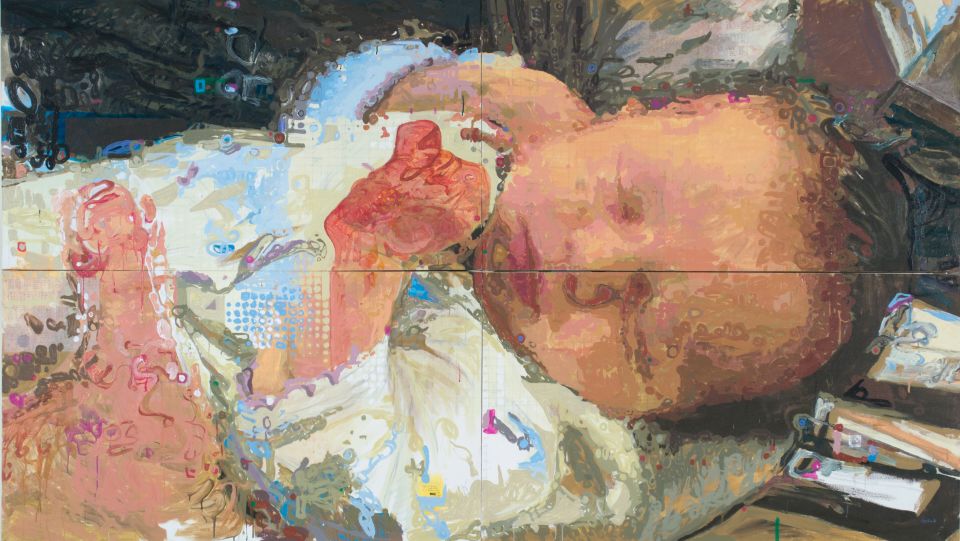About: Writings / Essays
-
About Baby Index 107 56



Wide shot and time-lapse of Baby, Index: (107, 56)
This work began as an exploration of photographic color relationships. It is a continuation of a painting process I have referred to as stealing color. I've made quite a few paintings incorporating this process. A photograph is taken of any subject. A GIF image is then made from it and then pushed through a script that deconstructs each color and reformulates each one to be mixed using a subtractive color method, inspired by CMYK printing processes. More information can be found here. The process of mixing colors using only primary colors is a cornerstone of printing and image production.
The sensory language I have been developing is informed by a heterogeneous combination of abstract forms and concrete information. Historically, the signifiers presented in works of art tend to be oriented around some kind of logic. This logic implies that our minds are trained to think in structures dictated by what our sense organs are telling us. This phenomenon leads to various mythologies we ascribe to "images"; mythologies such as the credibility of photographic evidence, the crucifixion of Jesus, or attaching political meanings to symbols. One's emotional involvement in these images is dependent on an attachment to the mythological subtext. The images themselves don't emerge from the emotional or subconscious imagination. They are logical connections to a sense organ (concrete) instead of an eruption from or expression of the artist's connection to the higher emotional state or collective unconscious (abstraction). One of my goals has been to develop an expressive language that conveys a sense of this stark divide between the logical "visually informed," world of signs and "images" (without tired and apparent references to simulacra) and the world of intuition, the subconscious and the expressive language of the higher-level emotive state of the psyche. Simply put, this would result in a combining of concrete and abstract visual languages.
A union of opposing linguistic systems seems far off each time I "complete" a painting. While the emotional, "collective unconscious," and abstract side of this dualistic language appears to have developed here and there. I've focused more attention on the "realism" of logical patterning of coordinates, mathematical calculations, algorithms, and color placement with this work. The work's emotional aspect is a bit more claustrophobic in overall tone, while the breadth of elements is much more understated. The mathematical, logical, calculating mechanistic process dominated the development of this work.
The possibilities for exploration as a painter using this mathematically logical method are wide open. But in the case of Baby: Index (107, 56), I realized that I was mimicking an activity very common in industrial/technological cultures. Which is to compulsively photograph people (children), document "experience," and disseminate the images using the internet. In essence, this practice feeds the "Culture Industry" or the pornography machine described by Theodor Adorno. That is to say that by perpetually supplying data to corporations, we are complicit in policies that we often criticize, such as "The Patriot Act," hence the "index" of the title. The XY coordinates (107, 56) also signify the bill that set the Patriot Act in motion. It also represents the XY coordinates on the painting for a collaged NFC chip, which for Android phone users, linked you to a "missing children" page, expanding the painting into an interactive work that incorporates digital technologies.
The "missing children" page then acts as an element of the work that the viewer/participant can take with them. The content of this page is updated when used. The content is data coming from an RSS feed from the National Center for Missing and Exploited Children.
So, this work is meant to pose a variety of questions. Whenever I develop interactive artwork, the intent is to place the viewer/participant in the center of the content. In this case, some questions could include the following:
How am I facilitating cultural phenomena I might otherwise claim to disagree with?
Am I complicit in human trafficking/slavery by shopping at (store name), buying an apple/android phone, purchasing this or that car, etc.?
What's the relationship between my actions and their impact on the world around me?
Do I need to post so many "selfies"?
Note: There could also be a further gordian knot of philosophical questions at work as well. More details of this work can be seen here -> Baby, Index (107, 56).
As of 2019, the government data that I was scraping changed to a different format. The archive microsite has been abandoned. Post a question or comment.
Tom Estlack | Subscribe
Subscribe-
-
Search - About
-
Documentation
Writings / Essays
- Artist Bio
- transcript for Advice for Young Executives
- Great Music Together
- About Baby Index 107 56
- Ishtar - Middle Eastern Bellydance Music
- About Codorus Creek Detritus
- Istanburgh
- Some Notes on a Painting Process
- Long Lost Friend
- Aspects of Late Postmodernism
- Brain of the City
- About Populace Fragments
- Yes Thank You - Curatorial Statement